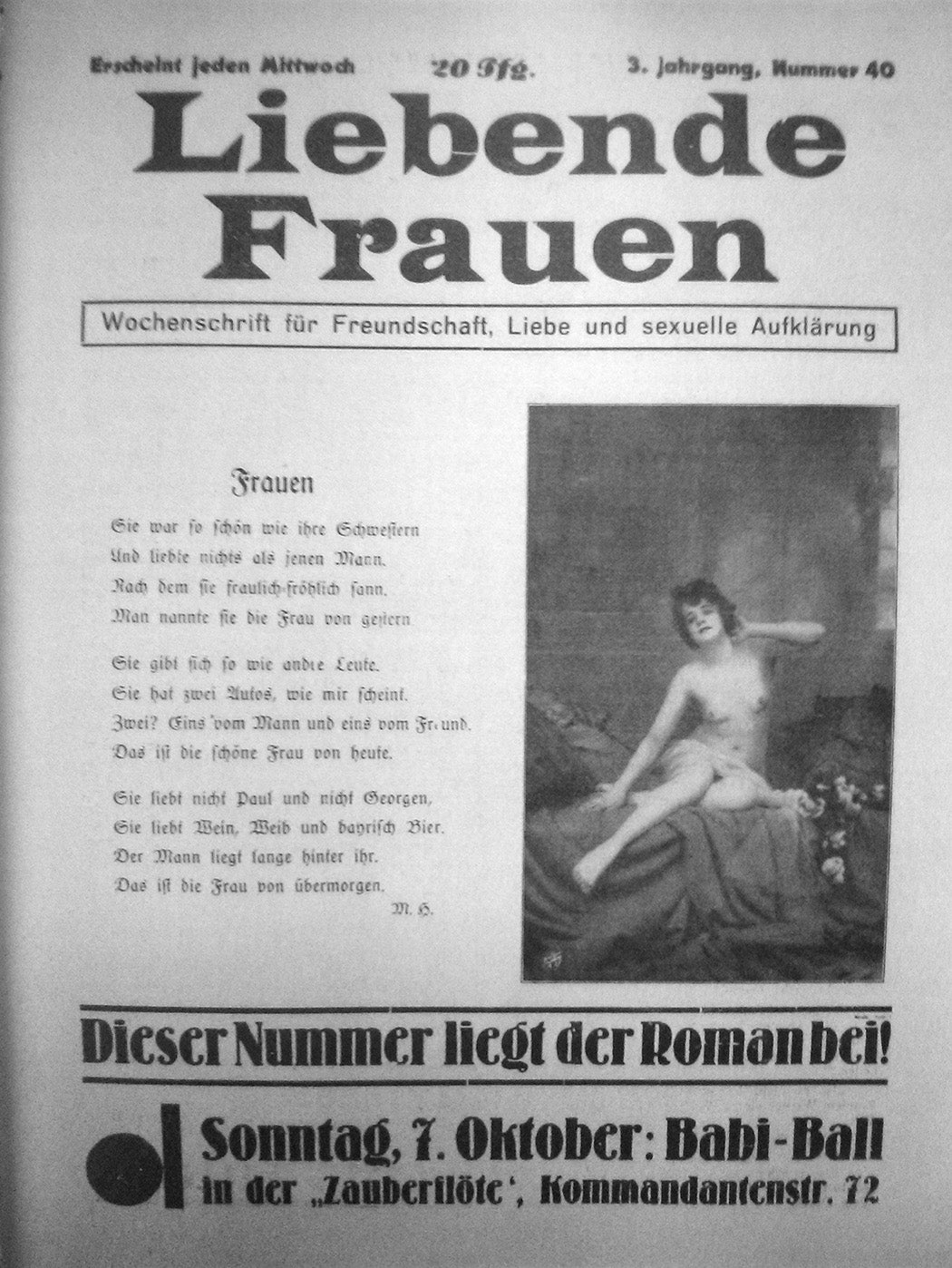Publishing Queer Berlin
Weimar Germany was an improbably safe space for newspapers and magazines by and for lesbians.
The post Publishing Queer Berlin appeared first on JSTOR Daily.
Berlin in the 1920s was ablaze with sexual and gender freedom. Magazines at newsstands boasted covers featuring people who were transgender and clad scantily. Their headlines touted stories on “Homosexual Women and the Upcoming Legislative Elections,” and offered, on occasion, homoerotic fiction inside its pages.
Publications like Die Freundin (The Girlfriend); Frauenliebe (Women Love, which later became Garçonne); and Das 3. Geschlecht (The Third Sex, which included writers who might identify as transgender today), found dedicated audiences who read their takes on culture and nightlife as well as the social and political issues of the day. The relaxed censorship rules under the Weimar Republic enabled gay women writers to establish themselves professionally while also giving them an opportunity to legitimize an identity that only a few years later would be under threat.
“Reading stories about other queer women was such a powerful way that women came to terms with their own queerness,” Laurie Marhoefer, a professor of history at the University of Washington, told me. “That was super important for women more than for men because men would just have more opportunities to find other queer people.” Marhoefer, who first learned of these publications as a graduate student in Berlin in the 2000s, is part of a growing group of academics focusing on this oft-forgotten moment in German history.
Such research is part of a wider interest in the Weimar Republic, bolstered by recent TV shows like Transparent (which drew connections between the 1920s and modern-day queer identity) and the gritty Babylon Berlin, whose characters include a female sex worker who spends her days as a detective. Benjamin Tallis described the appeal of these depictions in New Perspectives: “The visceral thrill of watching 1920s Berlin as a creative, decadent socio-cultural mecca, beset by suffering, and haunted by myriad ghosts yet alive with possibility, is tempered by the knowledge of the political abyss that awaits.”
Weekly Newsletter
[contact-form-7]Although these fictional tales tend to romanticize this interwar period, the primary source documents that miraculously survived the period of the Third Reich and subsequent and repressive Cold War years provide a richer and more complicated picture.
There were some twenty-five to thirty queer publications in Berlin between 1919 and 1933, most of which published around eight pages of articles on a bi-weekly basis. Of these, at least six were specifically oriented toward lesbians. What made them unique is the space they made for queer women, who had traditionally been marginalized on account of both gender and sexuality, to grapple with their role in a rapidly changing society. (The concept of the “new,” albeit straight, woman in the Weimar Republic has been researched broadly, including by Rüdiger Graf in Central European History, who writes that it reflected a crisis of masculinity following defeat in the First World War as well fears over the country’s future when women were putting off getting married and having children.)

In these interwar years in Germany, queer and transgender identity became more accepted, in large part thanks to the work of Magnus Hirschfeld, a Jewish doctor whose Institut für Sexualwissenschaft focused on issues of gender, sex, and sexuality. At the same time, women in Germany were making strides toward greater independence and equity; they gained the right to vote in 1918, and feminist organizations like Bund Deutscher Frauenvereine cultivated space for women in public spheres, encouraging their advancement in politics. As Sara Ann Sewell writes in the journal Central European History, the German Communist Party created the Red Women and Girls’ League in 1925 to attract more women and working-class people, particularly through organizing factory workers.
More generally, German women were becoming increasingly empowered. Queer people—including women—rallied around the abolishment of contemporary sodomy laws. This struggle “created a wider climate of publication, activism, and social organization that was much more embracing of different types of queer and trans lives,” according to Katie Sutton, an associate professor of German and gender studies at the Australian National University.
Like Marhoefer, Sutton came upon the Weimar-era lesbian publications in Berlin and was surprised that there wasn’t more engagement with these magazines or with the queer history of the Weimar Republic more broadly on the part of academics in the English-speaking world. Exceptions included the notable work of historian Claudia Schoppmann and her 1996 Days of Masquerade and Heike Schader’s 2004 Virile, Vamps, und wilde Veilchen (Virility, Vamps, and Wild Violets). The latter focused on the queer tropes that proliferated in lesbian magazine fiction of the time, and their creation, according to Sutton, of “codes of lesbian desire and lesbian eroticism” through color, flora, smells, and body parts, notably mouths, lips, hands, and breasts.
For its part, magazine fiction of the time challenged some of the restrictions of class and race in its love stories. A 1932 issue of Die Freundin, for instance, includes a story about a relationship between the German Töpsdrill and the Moroccan Benorina. Exoticizing of the “other” was common; Sutton points to another piece of fiction published in Ledige Frauen (Single Women) in 1928 about Helga, a German coffee importer, who falls for Nuela, a servant from Java. Notwithstanding the white, sometimes racist perspectives of the narrators, such stories offered compelling renderings of women-centered utopias.
Outside of fantasy, these publications also created a space for readers to assert themselves in the real world through personal ads and event listings. There included cream puff eating contests, ladies and trans balls, and lake excursions on paddle steamers. In fact, aspects of lesbian culture also seeped into the mainstream, particularly when it came to fashion, with a rise in the popularity of short haircuts, straight skirts, and pantsuits. There was little difference between the imagery in mainstream fashion magazines and the masculinized aesthetic eroticized in the queer ones. The “hint of queerness” in the mainstream, Sutton said, was “sexy and fascinating, but also a bit scary and potentially off putting.” A popular element in lesbian publications, the monocle was similarly charged, and, Sutton says, “a queerly coded, quite masculine symbol of owning the gaze.”

Such sartorial choices were in keeping with debates in the lesbian magazines of the time around the “extent that masculinity might be seen as hierarchically superior to that of the feminine lesbian women,” according to Sutton. Moreover, these debates foreshadowed the butch/femme debates of the 1980s and 1990s and the border wars of the late ‘90s and early 2000s.
Style was particularly significant for trans women and men who in the Weimar Republic defined themselves with a variety of terms: both as transvestites and masculine women who wore men’s clothes but identified as women. Trans people were given space in both their own magazines and even in some of the lesbian ones, highlighting a sense of cross-identity camaraderie. Die Freundin had a regular trans supplement highlighting these voices.
In a 1929 issue, a writer named Elly R criticized the treatment of trans people in mainstream media, referencing sensational coverage of men wearing their wives’ wedding dresses. “Everywhere in nature we find transitional forms, in the physical and chemical bodies, in the plants and the animals,” she wrote. “Everywhere one form passes into another, and everywhere there is a connection. Nowhere in nature is there a delimited, fixed type. Is it only in man that this transition should be missing? As there is no fixed form in nature, a strict separation between the sexes is also impossible.”

These magazines were resilient, a testament to the strength of the communities they served. Still, they faced challenges. The 1926 Harmful Publications Act was intended to impose moral censorship on the widespread pulp literature sold at kiosks and newsstands, including the queer publications, which often featured nude photographs.
The Catholic and Protestant Churches as well as public morality organizations and conservative politicians led the fight against what they called “trash and filth literature.” As Klaus Petersen explains in a German Studies Review article, the list of materials, which included at least seventy works on sexology and “filth literature,” could still be sold, just not to those under age eighteen. While “the instrument was blunt and [its] impact minimal,” the restriction was boosted by members of religious and youth groups that checked up on newsstands to see what material was visible or advertised to children. (This is not a far cry from the Nazi book burnings that would occur just a few years later.) But the law also spurred a counter-campaign by writers, publishers, intellectuals, and leftist political activists who objected to these limitations, as Petersen explains.
“This coalition of protest groups against infringements of the freedom of expression considered the Index a simplistic and entirely ineffective means to avoid an honest discussion of the fast change in social attitudes and moral values and campaigned against it as an unconstitutional instrument of suppression.”
Despite their relative progressivism, these publications also represented a rather narrow, bourgeois segment of the German population. Even if women had greater access to education and publishing opportunities, the women who enjoyed this greater access were largely urban elites. Little if no space was given to proletarian struggles. “Middle-class values of respectability and citizenship shaped the political agenda, with contributors drawing on the powerful language of national inclusion in formulating their demands of legal and social acceptance,” wrote Sutton in an article in German Studies Review.
It’s also important to note that whatever sexual liberation the LGBTQ+ community enjoyed was at the discretion of the state, whose goal was to control its members. This was seen in the Transvestitenscheine (“transvestite certificates”) handed out by the German police to protect against the arrest of those cross-dressing in public. Between 1908-1933, dozens of such passes were distributed. They also guarded against arrests for sodomy law violations and played a role in a 1927 battle over legalizing prostitution, largely aimed at preventing the spread of venereal diseases.
That said, the plight of sex workers was largely excluded from consideration in the publications in question, and mentions of their readers’ privilege were few and far between. Still, a 1929 Die Freunden article cautioned readers: “Don’t go to your entertainments while thousands of our sisters mourn their lives in gloomy despair.”
More notably, these magazines gave precious little foresight into what was to come in Germany: the attempted extermination of all who did not fit the Aryan ideal. That, of course, included lesbians, some of whom perhaps took steps to save their own skin. Ruth Roellig, who wrote for Frauenliebe and published Berlins lesbische Frauen (Berlin’s Lesbian Women) in 1928, a first-of-its-kind travel guide to queer Berlin, published a second book in 1937. Soldaten, Tod, Tänzerin (Soldiers, Death, Dancer), an anti-Semitic screed, proved to be Roellig’s last book, though she lived until 1969. Selli Engler, a lesbian editor who founded the magazine Die BIF – Blätter Idealer Frauenfreundschaften (Papers on Ideal Women Friendships), wrote Heil Hitler, a play she sent directly to the führer.
As feminist and queer activism grew in Germany in the 1970s, so too did interest in the Weimar period. In 1973, Homosexual Action West Berlin began to collect flyers, posters, and press releases in an effort to create a comprehensive archive of lesbian history. The group eventually morphed into Spinnboden, Europe’s largest and oldest lesbian archive, with more than 50 thousand items in its holdings, magazines among them. Katja Koblitz, who runs the archive, says the existence of these lesbian periodicals is invaluable.
“These magazines were in one part a sign of the blossoming and of the richness of the lesbian subculture in these days,” she said. “Reading these magazines was a form of reassurance: Here we are, we exist.”
Support JSTOR Daily! Join our new membership program on Patreon today.
The post Publishing Queer Berlin appeared first on JSTOR Daily.
